December, 2018

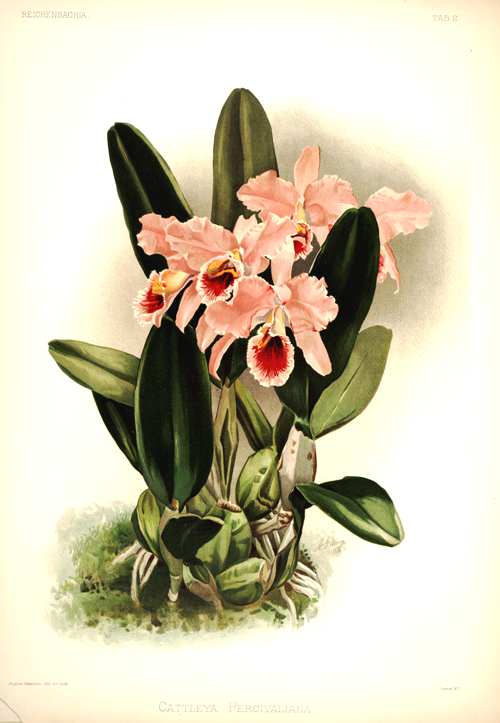
Plate 2 from Reichenbachia, vol. 1, 1888
A Blast from the Past: 1881 —
Cattleya percivaliana: An Appreciation.
Orchid fashions are cruel. Yesterday's darling plant may not
end up on today's trash heap, but it often disappears from collections. Hobby orchid growers lose their plants through
benign neglect, black rot, bugs, squirrels, rats, and other pests, or sometimes through accidents such as a failure of the
heating, cooling, or irrigation system, a very hot day, or a sudden frost. And orchid nurseries tend to stock not the
plants that every serious orchid grower "should" have, but, rather, those plants that are likely to sell. So it is, that
the wonderful plant you read about turns out to be unavailable from any of the nurseries you visit.
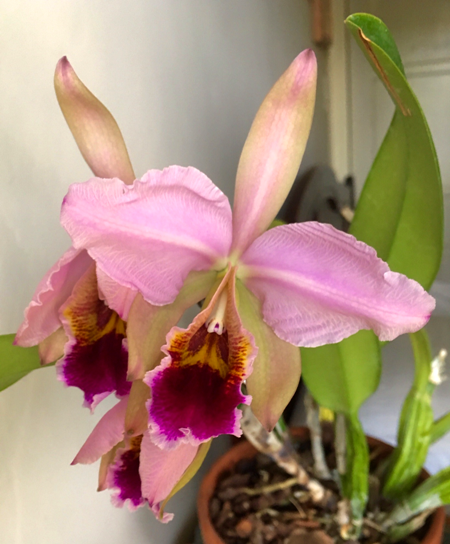
Just one day after opening, the lip is amazing!
There was a time when Cattleya percivaliana enjoyed commercial success as a potted plant for the Christmas season. While everybody was delighted by the intense colors and intricate pattern on the lip (like a "Persian carpet"), the flowers were judged too small for the corsage trade, as well as for the highly-publicized exhibitions where all the awards went to huge, floppy Cattleyas, or else massive specimen plants with hundreds of blooms. Yet there was something about percivaliana that appealed to just enough growers to keep it from disappearing entirely.
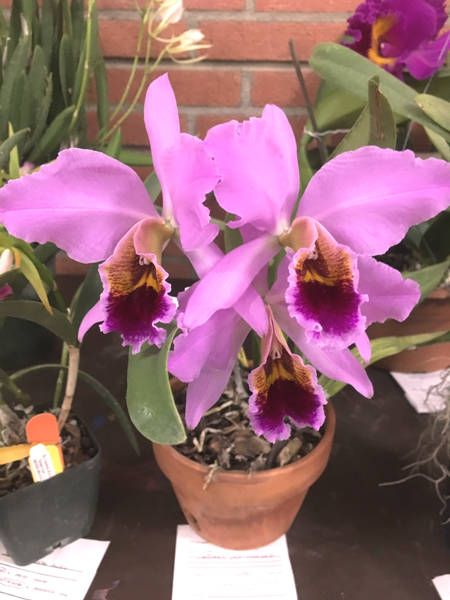
Same plant a few days later, on tour at SCOS meeting
C. percivaliana came late to the party. It was not discovered until 1881, many decades after most of the other large-flowered Cattleya species. At first, based on only a selection of herbarium material (dried flowers!) it was held to be just another variety of C. labiata, or else perhaps a poor relation of C. mossiae. There was a brief flurry of interest from the cut flower trade, hoping for a big orchid that bloomed between C. labiata (November) and C. trianae (January), until it became clear that the flowers of percivaliana were only half the size of those of the best labiata cultivars. By 1883, it was published as a new species, and the famous plate from Sander's Reichenbachia: Orchid Illustrated and Described (volume 1) was published in 1888. The plate, however, does not do justice to the beautiful details of the lip, nor to the overall color and form of the flowers.
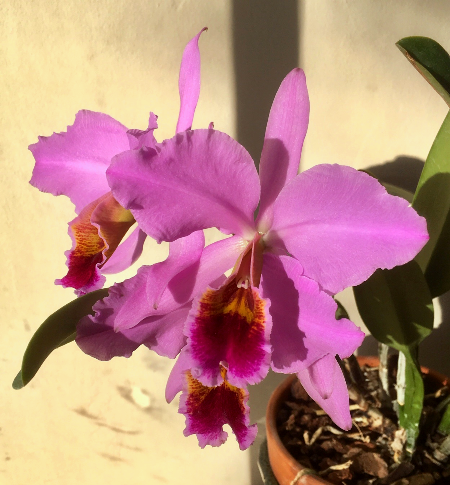
Safely back home, at its peak
The new plant proved something of a disappointment to hybridizers as well. The intense colors in the lip did not show up in the primary hybrids. Did anyone think of producing an F2 cross from one of the primary hybrids, in case the genes responsible for these colors happened to be recessive? Very few percivaliana hybrids seem to have had much of a following, but new crosses continue to be made. The lip is too intriguing for orchid breeders just to give up.
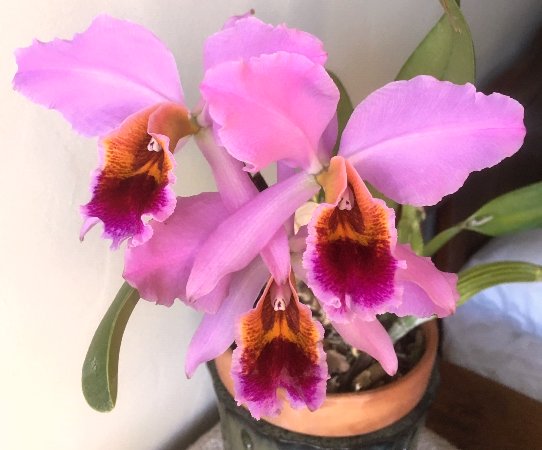
Two weeks after opening
Over the years, a number of "superior" cultivars have been discovered, including a few with much wider petals ('Summit', 'Meril'), alba forms, and some semi-albas as well ('Jewel', for example). Fortunately, it is still possible to find this species, and some excellent cultivars, at a few of our local nurseries. Recently, we saw divisions for sale at Sunset Valley Orchids and Santa Barbara Orchid Estate. And we spotted pictures of some excellent cultivars on Cal-Orchid's Facebook page — perhaps a sign of things to come! There are probably other local sources as well. Orchid nurseries, at least the successful ones, pay attention to what their customers want!
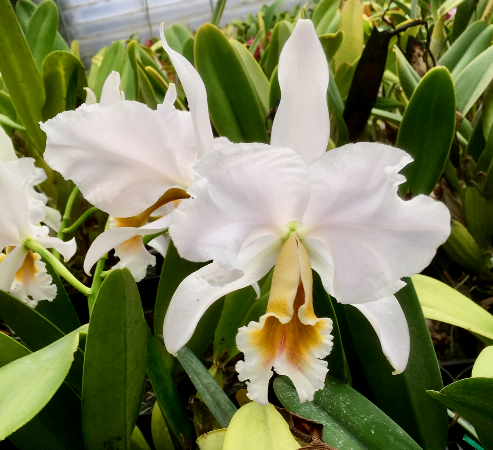
An alba form of C. percivaliana
This species turns out to be easy to grow outdoors in our area. It comes from highland forests (the Andes of Venezuela and, according to some reports, Columbia), sometimes growing on rocks. It can take a lot of light, provided it does not get too hot — so, shadecloth is a must during our hot summer days. The flowers seem to last for at least 2-3 weeks in captivity.
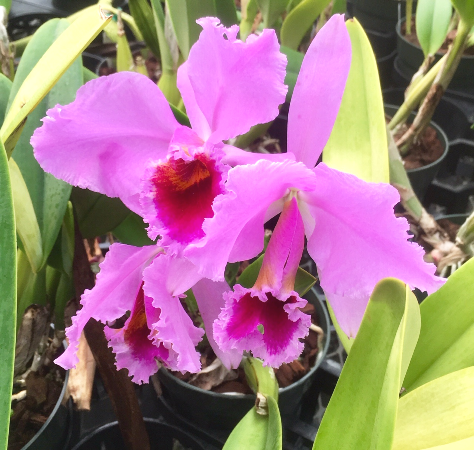
For further reading: Chadwick, A. A., and Chadwick, Arthur. E., 2006, The Classic Cattleyas, Portland, Oregon: Timber Press.
What should a percivaliana lip Look Like?
The deep colors of crimson-purple and gold, plus the strong markings, seem to be what makes C. percivaliana distinctive. But some of the cultivars (whether from nature or from the hybridizer's greenhouse) have more of one color or the other, and some have lips that are strongly tubular, so that the gold color and the pattern are hard to see. Which type of lip best marks what we want to see in this species?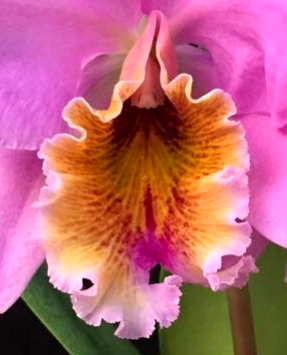
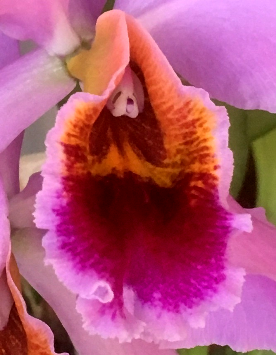
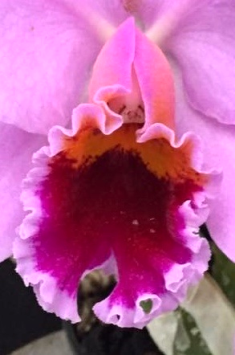
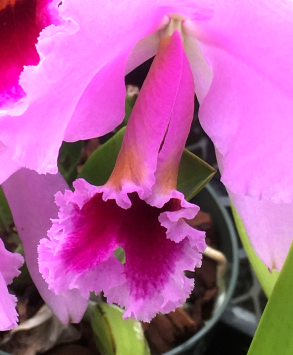
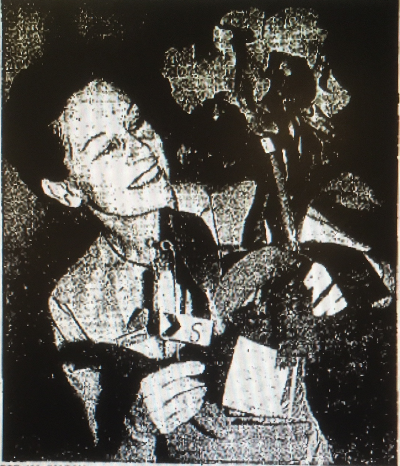
BEST IN SHOW. Exhibitor Grayce Hecker of Canoga Park
displays prize-winning Leleo Cattleya “Bonanza” orchid,
for which she turned down $1,000 offer Saturday. Thousands
of orchid plants currently are being shown
at Municipal Auditorium.—(Staff)
Blast from the Past: 1955 — More SCOS Stories from the 4th Western Orchid Congress
(Long Beach Independent, Sunday, November 13, 1955)
Woman Rejects $1,000 for Orchid. By Ben Zinser. You can become an orchid grower for as little as $2.50, insists John W. Hanes, general chairman of the Western Orchid Show ending at 6 p.m. today at Municipal Auditorium.
“Really, it’s not as expensive as most people think,” he adds.
Yet something was troubling Hanes, president of the South Coast Orchid Society.
He paused before a Leleo Cattleya, an entry of Mrs. Grayce Hecker, Canoga Park.
“A back bulb for $200, perhaps?” the San Gabriel man asked Mrs. Hecker, who with her husband operates a San Fernando restaurant.
“No,” she said, smiling.
* * * *
MRS. HECKER had reason to smile. Moments earlier someone had offered her $1,000 for the entire plant, which she calls “Bonanza.”
Mrs. Hecker admitted she thought this might happen. “Bonanza” is insured for $1,500.
The plant lived up to its name. It took four of the show’s ribbons, including that for best flower in show. There are about 300,000 plants on display.
Bonanza is a king-sized orchid. Its flowers possess a deep iridescent fuchsia shading with a touch of gold in the center.
It was grown in a plastic greenhouse and is one of 125 mature plants raised by Mrs. Hecker, who up until this year was an amateur grower.
Mrs. Hecker is a typical orchid grower. She drives to Long Beach from Canoga Park just to attend meetings of the South Coast Orchid Society.
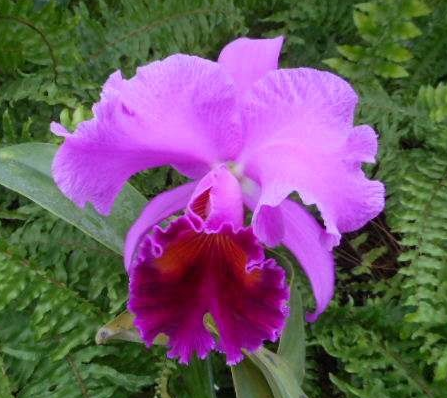
* * * *
SHE, OR HANES or any one of the dozens of others exhibiting orchids can tell you:
That when you say “make mine vanilla,” you’re eating an orchid. Vanilla extract comes from a tropical North American orchid.
That in the Philippines some of the natives use a butterfly orchid to make herb medicine.
That an orchid doesn’t have to be huge to be rare. The Ornithocephalus, found in Central America, is a dainty miniature botanical orchid. There’s one at the show, incidentally.
That orchid-growing gets in one’s blood.
* * * *
“THAT’S RIGHT,” commented a security policeman at the show. “We’re here to see that people keep their pocketknives in their pockets. Someone might want to whack off a bulb, you know.”
Most growers, however, have nothing but respect for an orchid plant, despite the catalog plea of a West Los Angeles firm which calls itself the “largest breeders of orchids in America.”
“First of all, remember that orchids are plants,” says the catalog, which is handed to visitors at the show, “Don’t be afraid of them.”
$1,000 for a prize-winning Cattleya? Hard to imagine today, but if we take into account inflation since 1955, the offered price would be worth about $9,400 in 2018 dollars! Times have changed, the availability of mericloned orchids has made these wonderful plants accessible to the hobby market. You can probably get a clone (or even a division) of an awarded Bonanza, near blooming size, for around $40, although the market seems to have moved on to more recent generations of big lavender Cattleyas, such as Norman's Bay, Amy Wakasugi, etc. But the reduced price has not made the earlier hybrids any less attractive or desirable.
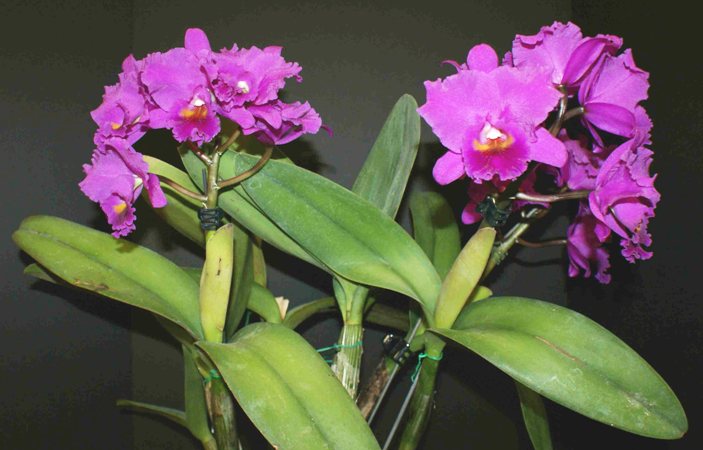
Ctt. Adolph Hecker 'Lynn' AM/AOS
Does anyone have this plant?
But wait! There's more! Grayce Hecker, by 1955 considered a commercial orchid grower, went on to create a number of hybrids, mostly using her Bonanza. The most successful was Lc. (now Cattlianthe) Adolph Hecker, C. (now Cattlianthe) Porcia × Lc. (now C.) Bonanza (Bracey), registered in 1959. By 1964, she and her husband had moved to Las Vegas, where we found this account of further developments in the local newspaper.
(Las Vegas Sun, Monday, January 20, 1964, p. 14) HELPFUL HANDS – Our town’s renowned orchid grower, Grace Hecker, has her new creation, the Adolph Hecker orchid, colonizing California and Florida.
In Los Angeles, the largest grower is reproducing it in quanty as (to quote his ads) “the best medium-sized bifoliate to be developed in years.” (Bifoliate heck! – it’s a by Hecker.)
In Florida, ex-Governor Gore is using it as a parent plant for further experimentation, Grace tells us.
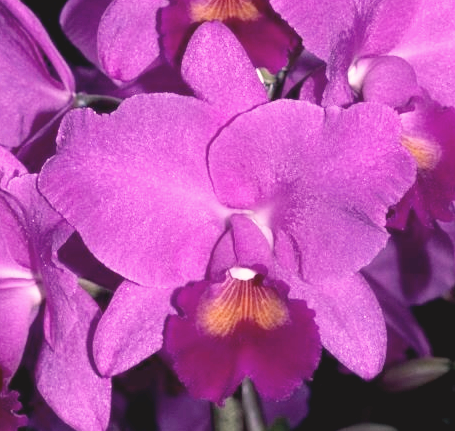
Adolph Hecker (the husband, not the orchid) took a plant of the species named after him up to Mercury to be raffled for a member of the motor pool up there, “Tiny” Hendricks, who had to have a foot amputated at the ankle.
The boys sold 50 tickets at $1 and the one who won the orchid plant is tickled pink with it. What’ll he do with it? “Become an orchid grower,” smiles the really tiny Grace, “that’s the way we get ‘em hooked.”
(Las Vegas Sun, June 7, 1966) — Grayce Hecker, who once won fame as an orchid hybridizer, still loves the beautiful blossoms. Recently she attended the World Orchid Convention in Long Beach, Calif. Ten years ago she won the top award with her Cattleya Bonanza Paydirt. I later wrote about it. Grayce reports that this year there was nothing near as good. Not one entry received as many points as hers, but she says it was a fabulous show and orchid hobbyists are increasing. She hopes there’ll be an orchid society here, mostly because she misses hers so much.